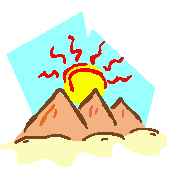BACKGROUND:
The “sphere” in lithosphere, atmosphere, and hydrosphere
means envelop. The atmosphere, therefore, consists of gases that
envelop the Earth. The hydrosphere defines the water that covers
71% of the Earth's surface. The lithosphere refers to the rocks of
the Earth’s surface and upper mantle, or the depth of the plates.
The atmosphere, hydrosphere, and lithosphere interact with each other to
make our planet liveable. Without any one of them, we could not survive
as a planet.
The atmosphere is layered. The layer we live in is called
the troposphere where we have wind, clouds, and all of our weather.
Within the troposphere the right mixture of oxygen with nitrogen, carbon
dioxide, and other rare gases allows organisms to survive. As you
go higher in the atmosphere, the mixture of the gases changes. The
temperature also changes.
The layer above the troposphere is called the stratosphere and
is about 32 km thick. The upper part of the stratosphere is called
the ozone layer. Ozone is a form of oxygen that help protect the
surface of the Earth from the Sun’s ultraviolet rays. Ozone is not the
same form as the oxygen we breathe.
The next layer is called the Mesosphere which is colder than
the stratosphere. This is followed by the Ionosphere where the temperature
rises.
 The amount of air also varies in each of the layers. Close
to the Earth the air is concentrated and under pressure, while at about
35,000 meters (115,000 feet) the weight of the air is just one one-hundredth
of the surface value. In other words, if you were in an airplane
that high, you could not breathe if you were outside of the plane.
The amount of air also varies in each of the layers. Close
to the Earth the air is concentrated and under pressure, while at about
35,000 meters (115,000 feet) the weight of the air is just one one-hundredth
of the surface value. In other words, if you were in an airplane
that high, you could not breathe if you were outside of the plane.
PROCEDURE:
- Discuss with students the terms atmosphere,
hydrosphere, and lithosphere. Use as many examples as you can.
This diagram is a guideline of some of the points you should
go over.